Cou
National Hazard
   
Posts: 958
Registered: 16-5-2013
Member Is Offline
Mood: Mad Scientist
|
|
(Lab report) Making benzyl acetate by fischer esterification
Benzyl alcohol esters are trickier to make than esters of aliphatic alcohols, due to reactivity of the aromatic ring. Benzyl alcohol is prone to
polymerization and sulfonation, so it's important to use a small, catalyst amount of sulfuric acid as catalyst, or anhydrous hydrogen chloride
catalyst.
Ever since I saw this chart, I've been very interested in organic chemistry for the fact that every molecule has a unique aroma, so I set out to start
collecting esters by combining alcohols and carboxylic acids.

Here is a list of all the acetate esters I had in my collection before making this one, and their scents:
methyl acetate (glue)
ethyl acetate (fruity)
propyl acetate (pears)
isopropyl acetate (pears)
butyl acetate (apple)
sec-butyl acetate (Grape)
isobutyl acetate (Cherry, like cherry-flavored starbursts)
pentyl acetate (banana)
isopentyl acetate (banana, like banana-flavored candies)
hexyl acetate (Green, pear)
heptyl acetate (rum, woody)
octyl acetate (orange, mushroomy)
nonyl acetate (Green, floral, mushroomy)
methyl salicylate (Root beer, mint lifesavers)
isopropyl salicylate (green, floral, leather)
Benzyl acetate is supposed to smell like jasmine, but I can't compare because i don't know what jasmine smells like.
It's important to use a large excess of acetic acid, and reflux for a long time, to convert as much benzyl alcohol as possible to benzyl acetate.
Undergrad organic chemistry labs do fischer esterifications with short-chain alcohols that are easily extracted with water washes, but fatty alcohols
are difficult to separate from their respective esters.(1)
When making aliphatic esters, the amount of sulfuric acid catalyst doesn't matter much. I usually go for a molar ratio of 0.1 moles sulfuric acid for
every mole of limiting alcohol. But benzyl alcohol is sensitive to too much sulfuric acid; using a .15 molar ratio caused most of the benzyl alcohol
to polymerize. A 0.05 molar ratio works.
chemicals:
10.00 mL benzyl alcohol (0.09635 mol)
Boiling point: 205.3 degrees C (source: CRC Handbook of Chemistry and Physics)
Density: 1.0419 g/mL
Molar mass: 108.138 g/mol
30.41 mL glacial acetic acid (0.4818 mol) a 5-fold molar excess to the alcohol
Molar mass: 60.052 g/mol
0.25 mL conc sulfuric acid (0.0047 moles) 0.05 molar ratio to the alcohol
Product: Benzyl acetate. BP: 215.1 degrees C. Density: 1.0550 g/mL. Molar mass: 150.174 g/mol.
Vogel's Practical Organic Chemistry contains a procedure for synthesis of benzyl acetate which does use sulfuric acid as the acid catalyst, in a
similar molar ratio to what I used.
I refluxed for 14 hours in a 50 mL round bottom flask. I always get an orange mixture from this specific reaction of benzyl alcohol and acetic acid.

I poured it into a separatory funnel, and added an equal volume of distilled water to cause the ester layer to separate to the bottom. However the
density was so close that an emulsion forms easily. In the future I would add salt, which would cause the ester layer to cleanly separate on top of
the aqeuous layer instead.

I then washed with saturated sodium carbonate solution until it no longer bubbles on addition, then added salt to break the emulsion so the ester
layer separated on top. The acid neutralization should not only extract acetic acid and sulfuric acid, but also sulfonated compounds. The crude ester
was 10 mL of an orange liquid with a floral aroma.
Dried with calcium chloride
On simple distillation, 6.74 mL of colorless benzyl acetate distilled over with a boiling point of 217 deg C (compare to CRC literature value of 215.1
C), so I decided there was no need to separate unreacted benzyl alcohol with a deep eutectic mixture of glycerol and choline chloride. In the past
when I tried this, there was still unreacted benzyl alcohol and the ester distilled at 185 C. the distilling flask was left with tar which is soluble
in toluene and xylene.
I added the benzyl acetate to my collection of esters. It smells pleasant and flowery.

the boiling point is a little high, and i found a little harshness in the smell. Do you think it might be contaminated with sulfonated benzyl alcohol,
or sulfonated benzyl acetate?
1: Pavia, Donald L.; Lampman, Gary M.; Kriz, George S. Isopentyl Acetate (Banana Oil). In A Microscale Approach to Organic Laboratory
Techniques, 6th ed; Cengage Learning: Boston, 2018; pp 110.
[Edited on 13-5-2020 by Cou]
[Edited on 13-5-2020 by Cou]
[Edited on 13-5-2020 by Cou]
|
|
|
DraconicAcid
International Hazard
    
Posts: 4278
Registered: 1-2-2013
Location: The tiniest college campus ever....
Member Is Offline
Mood: Semi-victorious.
|
|
I remember asking the author of that poster if he meant "benzyl" or "phenyl" when he said "benzyl (benzene ring)", and he said he couldn't remember.
I don't have any benzyl alcohol, so I haven't tried making any of its esters.
Please remember: "Filtrate" is not a verb.
Write up your lab reports the way your instructor wants them, not the way your ex-instructor wants them.
|
|
|
Cou
National Hazard
   
Posts: 958
Registered: 16-5-2013
Member Is Offline
Mood: Mad Scientist
|
|
He meant benzyl. Benzyl acetate is known for smelling like jasmine, which is what is listed in the chart
|
|
|
j_sum1
Administrator
       
Posts: 6223
Registered: 4-10-2014
Location: Unmoved
Member Is Online
Mood: Organised
|
|
Thanks Cou.
I was just yesterday considering how I would teach esters to my students and thought I might video a synth as soon as I can stand up in the lab.
Having just gotten an order of benzoic acid I was considering ethyl benzoate.
I know what jasmine is like. (Very fragrant.) I have no idea about ylang ylang.
|
|
|
Fery
National Hazard
   
Posts: 990
Registered: 27-8-2019
Location: Czechoslovakia
Member Is Offline
|
|
j_sum1 - natural ylang-ylang is beautiful, one of my favorites (together with pear and pineapple), I got it quite cheap here: https://fichema.cz/ylang-ylang-silice/1742-ylang-ylang-silic...
(in fact, I ordered most of essential oils they had in stock just to be more skilled in scents, it was more than 20 essential oils for approx 100 EUR)
I can't yet compare with synthetic (methyl benzoate, ethyl benzoate) - did not yet perform the synthesis, I asked for the methyl benzoate some time
ago and the seller replied that he smelled it as not pleasant (I asked him to offer me other things he had in stock with pleasant scents too) and
later he went in trouble so the purchase was not made
|
|
|
DraconicAcid
International Hazard
    
Posts: 4278
Registered: 1-2-2013
Location: The tiniest college campus ever....
Member Is Offline
Mood: Semi-victorious.
|
|
Ylang ylang is something I actually know.....a woman I used to date in university now sells essential oils, and sent me some ylang ylang oil because
she thought it would work better than antidepressants.
Sigh....yeah, I knew how to pick 'em back then......
Please remember: "Filtrate" is not a verb.
Write up your lab reports the way your instructor wants them, not the way your ex-instructor wants them.
|
|
|
Cou
National Hazard
   
Posts: 958
Registered: 16-5-2013
Member Is Offline
Mood: Mad Scientist
|
|
I wasn't scared of COVID-19 until I found out it can cause permanent loss of smell.
|
|
|
j_sum1
Administrator
       
Posts: 6223
Registered: 4-10-2014
Location: Unmoved
Member Is Online
Mood: Organised
|
|
Hmmm. It can cause permanent loss of all body functions. But a bit of statistical thinking helps to keep everything in some sort of perspective.
And for what I came here to write...
It looks like essence of ylangylang is on the cards then. It could be fun to do.
|
|
|
karlos³
International Hazard
    
Posts: 1520
Registered: 10-1-2011
Location: yes!
Member Is Offline
Mood: oxazolidinic 8)
|
|
I was, as usual, disappointed by benzyl acetate!
Jasmin smelling sounded very nice and since I had the reagents on hand, I tried it... and I have to say, it smelled only very faint after flowers, but
the dominant notion I got from it was without a doubt definitely pear!
A ripe pear, and a good smell, but absolutely not jasmin.
You know that you can easily use a different approach to get a product free of benzyl alcohol?
I know your topic is about the fischer esterification in special, yes, just want to mention it because it is one of the few esters I ever made myself.
And I've used this method, since I wanted to see if the ester really smells like jasmin... 
If you react the BnOH with HCl, you can use the so obtained BnCl for a reaction with sodium acetate.
You might need a PTC agent though, but thats no problem, simply a splash of fabric softener should do this: https://pubs.acs.org/doi/abs/10.1021/ed068p69
I had commercial benzyl chloride on hand so it was very simple for me.
Oh, and no worries about the lachrymatoric quality of benzyl chloride, thats not as bad.
And you don't want to create liters of the ester either.
I smelled the occasional whiff during that and this is harmless when compared to the bromoketones I've worked plenty of times, in amounts up to a few
dozen grams, with.
I thought I mention this, because you might have been put off this route because of its properties as a lachrymator, but in reality it is not a bad
choice to make benzyl esters.
At least lacks the issues you have with the fischer and goes better to completion.
|
|
|
Cou
National Hazard
   
Posts: 958
Registered: 16-5-2013
Member Is Offline
Mood: Mad Scientist
|
|
Yea benzyl acetate doesn't have a very interesting smell. Pear-like smell. but more floral than propyl acetate
Quote: Originally posted by karlos³  | I thought I mention this, because you might have been put off this route because of its properties as a lachrymator, but in reality it is not a bad
choice to make benzyl esters.
At least lacks the issues you have with the fischer and goes better to completion. |
i like fischer esterification because it's a general method that works for most carboxylic acids and alcohol combinations, if you're trying to build a
collection of esters like me. The method of SN2 substitution of a carboxylate ion displacing bromide, it works best for benzyl halides b/c of their
reactivity, but not as well for other alkyl halides. Alkyl halides are also carcinogenic and exposure should be minimized.
Yield doesn't matter if you're building a collection of aroma compounds. but i still will consider your suggestion for benzyl alcohol esters
specifically
[Edited on 14-5-2020 by Cou]
|
|
|
Fery
National Hazard
   
Posts: 990
Registered: 27-8-2019
Location: Czechoslovakia
Member Is Offline
|
|
I finished this synthesis right now. The scent of the product has maybe at most 1/4 of scent of pears or some fruit and 3/4 of something else. For
pears I have n-pentyl acetate which is the best, then n-propyl acetate which is not as good as the pentyl and this benzyl acetate is even less
pears-like than the n-propyl. For jasmine I have racemic methyl dihydrojasmonate but it does not have any scent for me (maybe it requires elevated temperatures, but from the bottle I do not scent
anything).
So the scent of benzyl acetate is something which I do not know how to describe exactly. The pears or some fruits are only marginal, the main is
something else. If this is how the jasmine scents then I will know for future.
Btw the reactant benzyl alcohol I scented also for the first time in my life and it has a nice scent of rose.
I performed the synthesis at 0,5 mol scale.
To 250 ml RBF was added:
- boiling stones (5 small glass balls)
- benzyl alcohol 0,50 mol 54,1 g (M=108,14 g/mol)
- acetic acid 0,75 mol 45,0 g (M=60,05 g/mol) = 50% excess (some of it will be lost with water distilled out of the reaction)
- 0,25 ml 96% H2SO4 (it caused some precipitate so maybe better would be dissolving H2SO4 in acetic acid and then addition to benzylalcohol), yes
that's not error, only 1/4 ml = that's about 0,5 g = that's about 1/100 of molar mass of reactants, its only a catalyst, using too much would cause
tar formation and side reactions especially at the end when the excess of H2SO4 would not dissolve and start to separate at the bottom)
through the condenser was added 25 ml of medicinal petrolether (hydrogenated fraction, b.p. 60-65 C = isohexanes) - also hexane, cyclohexane, benzene,
heptane could be used - volume must be more than the volume of Dean-Stark trap adapter, I used 10 ml adapter + it has some volume maybe 5 ml above the
10 ml graduation.
Refluxed.
20 minutes reflux 5,0 ml water collected
35 minutes reflux 9,0 ml water collected
45 minutes reflux 12,0 ml collected, no more immiscible drops on the arm of Dean-Stark trap apparatus (see photos for explanation, that means all
water was already removed), that should be 0,50 mol H2O = 9 ml of reaction water and some acetic acid distilled out with the water
Reflux continued for 60 more minutes to ensure all water removed, during this time perhaps some unreacted acetic acid collected in Dean-Stark trap
which was initially in 50% excess.
When the volume was above 10 ml graduation in the adapter, part of it was drained to beaker (but not too much so more isohexanes were in reaction
flask than in the trap adapter). Finally all water phase was drained to beaker and its weight was 17,7 g = 9,0 g reaction H2O and the rest 8,7 g
should be acetic acid, initially an excess 0,25 mol = 15 g was used so this is fine.
Cooled to room temperature.
Using 250 ml separatory funnel:
washed 2x 100 ml water, kept upper organic layer and discarded bottom aqueous layer (note without isohexanes the ester would be bottom layer as its
density is 1,05-1,06 g/ml)
washed 1x 75 ml 5 % NaHCO3, only minimal evolution of CO2
washed 1x 100 ml water
Dried with anhydrous Na2SO4 while magnetically stirring for 2 hours in a beaker closed with plastic foil + rubber band.
Decanted into 250 ml distillation RBF. Crystals of drying agent washed with little of isohexanes which was added into RBF.
Petrolether distilled out at atmospheric pressure.
Vacuum predistilled using lazy setup (without condenser) and water aspirator pump, collected 1,5 g of forerun (this should not contain isohexanes as
they do not condense to liquid at this temperature and this vacuum level) - see photos for explanation of the lazy setup.
Vacuum distilled using 2-stage oil rotary vane vacuum pump (unknown level of vacuum but it reduces b.p. of 2-nitrotoluene from 222 to 70 C).
Everything collected as forerun was already removed previously in predistillation using lazy setup. Almost everything distilled at 58,5 C. Close to
the end of distillation the temperature rose slightly as most of the walls of RBF was without liquid inside so was heated at higher temperature and
only little of ester was at the bottom of flask. At 60,5 C the distillation was stopped by opening valve and allowing air to enter the apparatus.
Yield 67,9 g = 0,45 mol = 90% (M = 150,18 g/mol)
Remainder if distillation flask 2,5 g.
Comparison of esterification with and without of azeotropic removal of water:
Cons:
necessity to distill off the isohexane
necessity to buy isohexane and it must be hydrogenated fraction, strictly not containing alkenes as they could hydrate into alcohols on H2SO4 catalyst
necessity to buy Dean-Stark trap apparatus
maybe traces of isohexanes stay in the product but almost nothing after vacuum distillation (moreover small amounts would be lost in scent of
something strong)
Pros:
better yield = quantitative as all water removed
you see that the reaction is complete in less than 1 hours and you continue reflux for 1 more hour to be sure, no need to wait half a day
esterification runs at lower temperature = reduces formation of ether / sulfuric acid ester from alcohol, no tar formation
only very little of H2SO4 is necessary, 1/100 molar ratio is enough
specific gravity of mixture is lower = organic phase stays as upper layer in separatory funnel, then is easier to drain and discard bottom layer and
the upper layer stays in sep. funnel
presence of isohexanes prevents formation of emulsion = easier and faster separation of phases in sep. funnel
you can also wash a little of product adhering on walls of separatory funnel and on crystals of drying agent using a little of isohexanes (few %
better yield)
during distilling off the isohexanes that removes also last traces of water present after drying with Na2SO4
Is benzylalcohol hard to esterify with acetic acid? Only a myth by my opinion.
reagents used
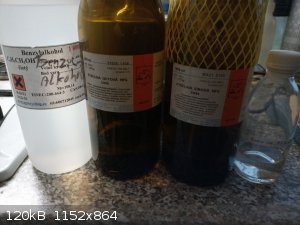
addition of H2SO4 caused some precipitation, maybe better to dissolve it in acetic acid and then add to the benzyl alcohol
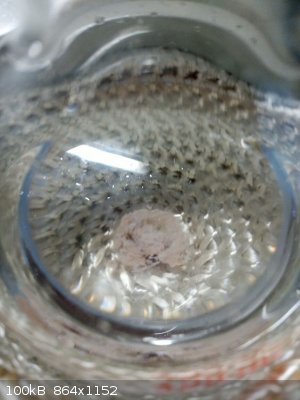
apparatus
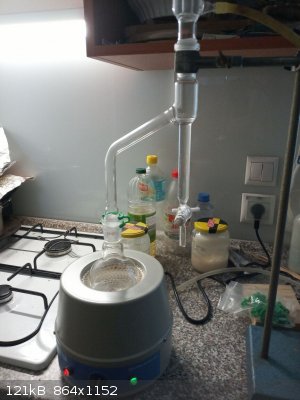
at the beginning of reflux there were 2 immiscible liquids visible at the side arm of the Dean-Stark trap apparatus
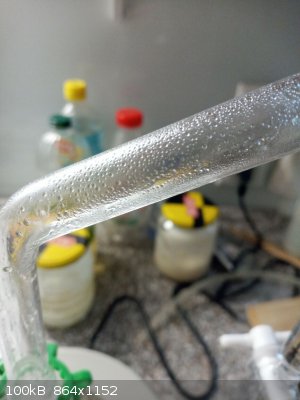 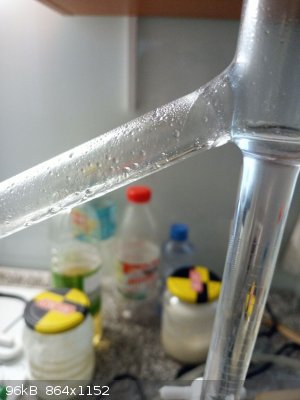
collecting water in trap adapter, when it was circa 2 ml above 10 ml, part of it was drained into beaker to keep the level at 10 ml (so only a little
of isohexanes stay in trap and most are in the reaction), note at the second picture the side arm of the trap adapter is still full of 2 immiscible
liquids forming droplets, on the third picture the side arm of the trap is smooth, without droplets of 2 immiscible liquids, also picture 4 (smooth
side arm of the adapter), anyway after that sign that all water was remove the reflux was continued for further 1 hour to remove last traces of water
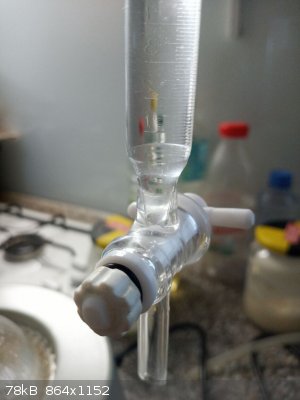 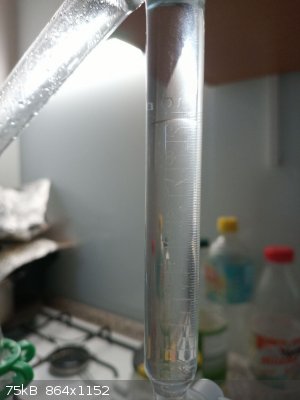 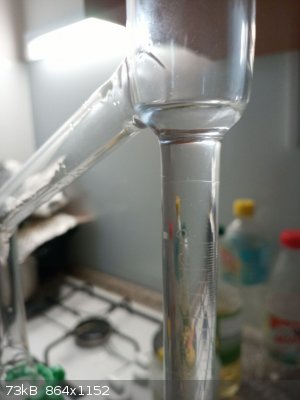 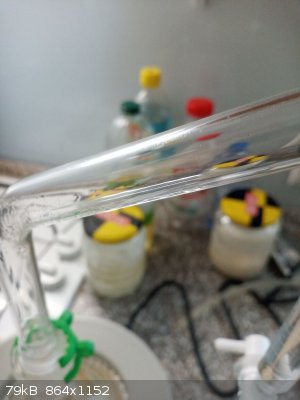
after reflux (there are 5 small amber glass balls on the bottom used as boiling stones)
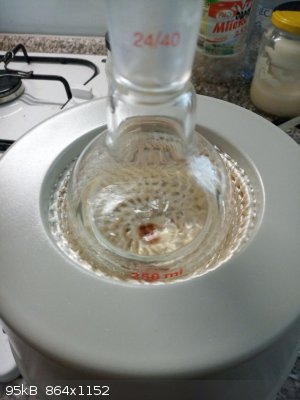
washed with 100 ml water, 100 ml water, 75 ml 4% NaHCO3, 100 ml water
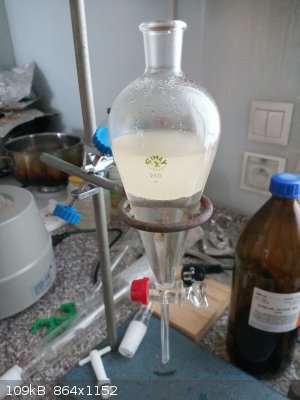 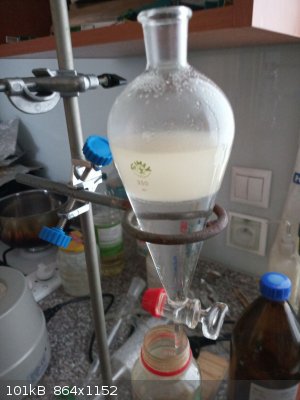 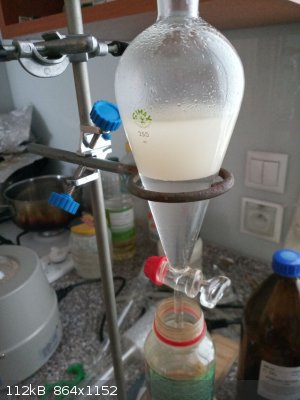 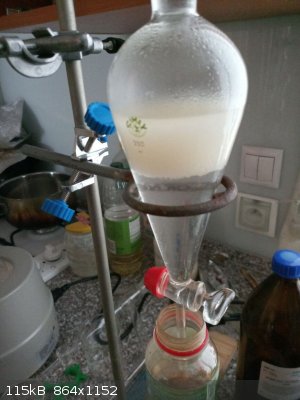
drying with Na2SO4 for 2 hours on magnetic stirrer
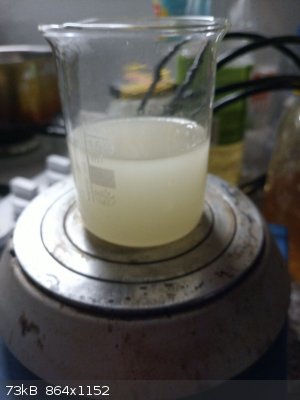 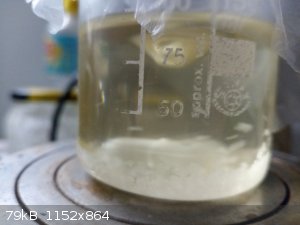
distilling out isohexanes at atmospheric pressure
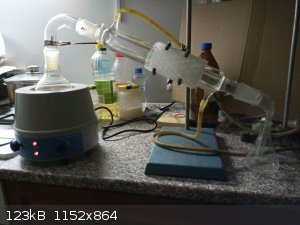
predistillation at water aspirator pump vacuum level using lazy distillation setup... last traces of water and isohexanes removed... 1,5 g of forerun
collected which condensed on cold glass, no need to use condenser
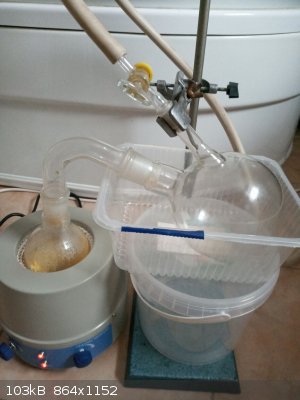
|
|
|
Fery
National Hazard
   
Posts: 990
Registered: 27-8-2019
Location: Czechoslovakia
Member Is Offline
|
|
vacuum distillation using regular vacuum distillation setup and 2-stage oil rotary vane vacuum pump
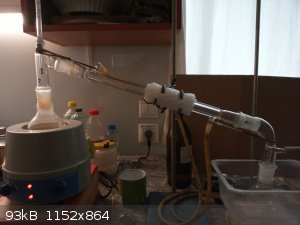
thanks to already removed forerun in predistillation the product started to distill at 58,5 C without forerun, during winter time when cold water is
really very cold the product condensed already at the beginning of condenser, most of the product distilled at stable 58,5 C, distillation finished
when reaching 60,5 C
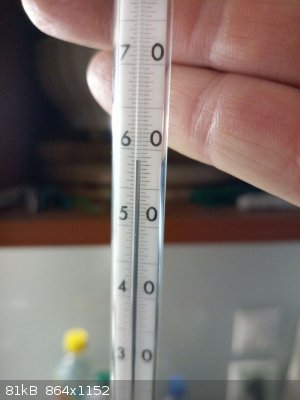 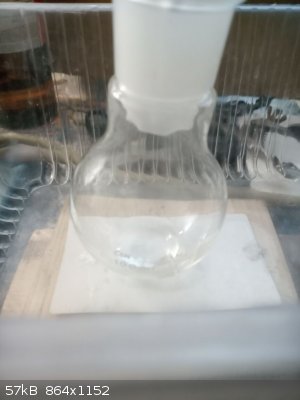 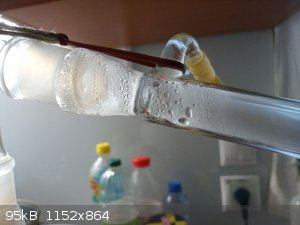 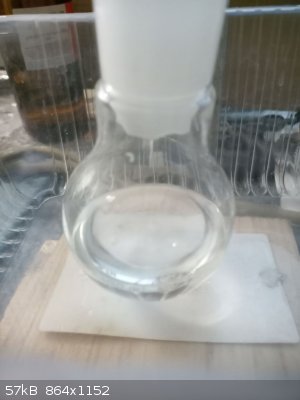 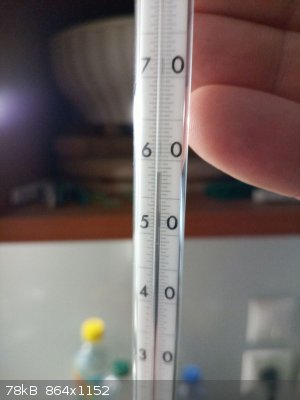 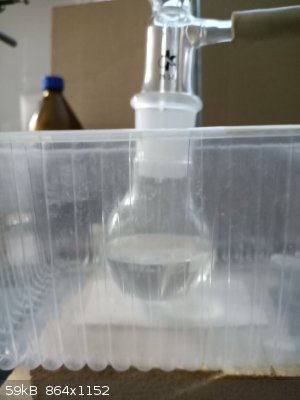 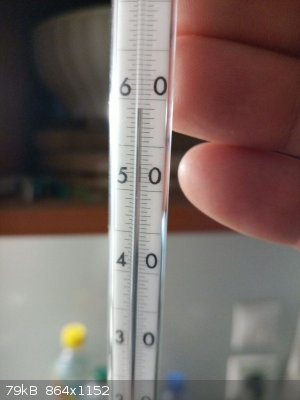 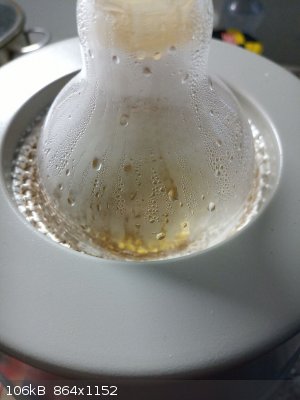 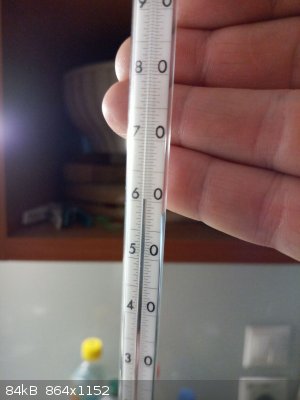 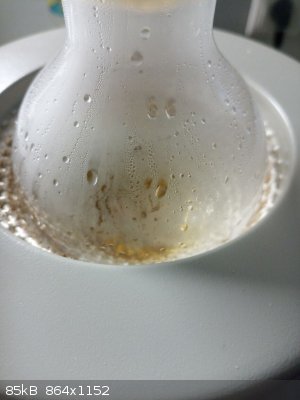 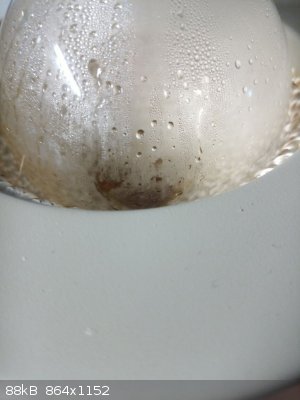 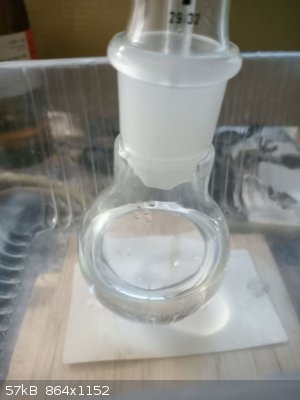
remainder in distillation flask 2,5 g and main fraction 67,9 g
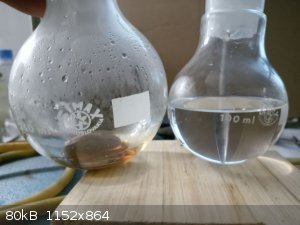
|
|
|
|